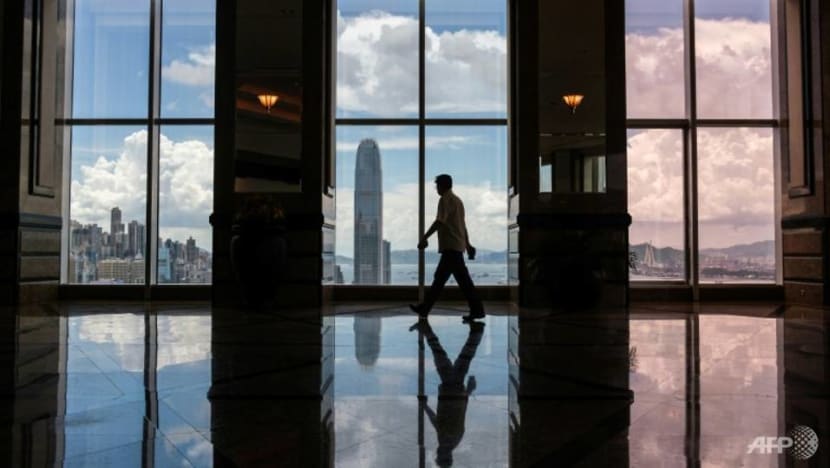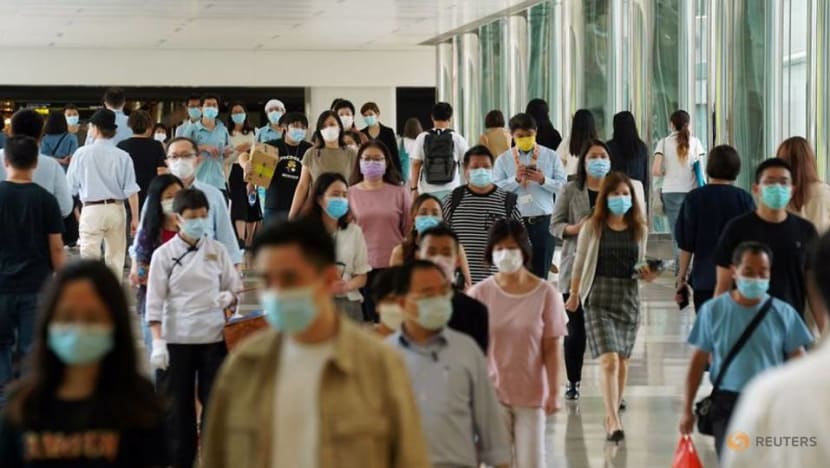commentary Commentary
Commentary: How did Hong Kong get to a third wave of COVID-19 infections?
After a year of dealing with protests and months fighting the pandemic, Hong Kong residents have become nonchalant, says Doris Lam.

More than 800 infections had been confirmed in the last fortnight alone in Hong Kong. (Photo: AFP/ANTHONY WALLACE)
SINGAPORE: Not even a month after Hong Kong further relaxed its social distancing requirements, the city has been hit by the third wave of new, untraceable local COVID-19 cases, prompting the government to introduce the city’s strictest yet social distancing measures which came into effect starting last Wednesday (Jul 15).
The latest surge emerged when a cook from a restaurant caught the virus, and may have been turbocharged after a professional caregiver who visited 10 aged care homes and accompanied more to their healthcare checks tested positive.
There are now over 700 new cases in the span of just under two weeks, with a much older group of patients affected. The situation has become more critical as isolation wards have reached 80 per cent capacity.
Hong Kong has more than 2,000 confirmed cases and 14 deaths as of Thursday (Jul 23). 86 out of the 108 new confirmed cases were locally transmitted – a dramatic increase from the city’s 17-day zero local case streak earlier this month.
READ: Commentary: To save its markets, Hong Kong needs to rely on China
READ: Commentary: China really wants Hong Kong to succeed
While the government had hoped a week of social distancing measures could keep the virus under control, it seems unlikely Hong Kongers will be going back to their pre-quarantine life anytime soon.
To fight this wave, chief executive Carrie Lam announced on Sunday (Jul 19) that civil servants will work from home and laid out the city’s plan to build 2,000 additional quarantine units near Hong Kong Disneyland.
Citizens are also required to wear face masks in indoor public places in addition to public transportation, while the ban on dine-in services from 6pm to 5am has been extended for another week.
With only a few days to prepare for the city’s sweeping social distancing measures, Hong Kongers were quick to accept and adapt to the new rules, learning from the city’s previous round of social distancing measures from March to May.

As bars, karaoke lounges and other units were ordered to close, restaurants introduced takeaway menus and delivery options to minimise losses.
HONG KONG RESIDENTS’ NONCHALANT ATTITUDE
Unlike the first time around, however, Hong Kongers seem to be less fearful of the virus despite its rising tally.
Companies, for instance, have been comparatively slower to implement work-from-home arrangements, while MTR trains remain relatively packed during rush hours. Instead of staying closed-off at home, citizens have taken socialising activities outdoors by going on picnics and hikes.
Though outdoor gatherings have not been identified as reason for specific clusters, such actions could hasten community spread.
Some citizens even decided to break social distancing regulations to honour the one year anniversary of the violent Yuen Long attack. Dozens gathered on Sunday (Jul 19), leading to four arrests for unlawful assembly and several fined for breaking social distancing regulations.
The city’s new re-imposed measures take away a lot of the freedom Hong Kongers have enjoyed the last few months.

After fighting against the pandemic for months, navigating through Hong Kong protests for over a year, and learning about the newly introduced national security law, Hong Kongers are almost numb to the never-ending stream of negative news, which may partially explain citizens’ nonchalant attitude to the new social distancing measures.
While the recurrence of the epidemic in the city is within expectations currently, experts say that the third wave is the worst Hong Kong has faced so far – and it seems like we have no one to blame but ourselves.
As Hong Kong’s COVID-19 rates remained steady for the last two months, the government introduced a “suppress and lift” strategy in mid-June, and allowed public group gatherings to up to 50 people, according to an exclusive report by South China Morning Post.
While the majority of Hong Kong remained vigilant with wearing masks, Hong Kongers slowly and expectedly eased off on following protective measures as vigilantly as before.
READ: Commentary: What next for Hong Kong and its people?
READ: Commentary: Autonomy cannot be Hong Kong’s future. Hong Kongers know this
You can see people taking off their masks in certain places such as beaches, restaurants or group gatherings, while streets, shopping centres and public transport quickly became as packed as pre-COVID days, showing no sign of a pandemic if not for covered faces.
HONG KONG GOVERNMENT TO BLAME TOO
Although the Hong Kong government’s management of the coronavirus in the first two waves deserves credit, with mass testing and social distancing rolled out rapidly, it too now must shoulder part of the blame for the city’s third wave outbreak.
Eager to lead as a success story in the fight against the virus alongside New Zealand and Taiwan, the Hong Kong government softened rules for tests and quarantine arrangements for airline and cruise crews, thus allowing citizens to return to daily lives by reopening high-risk, high-contact spaces such as gyms, clubs and restaurants.
Although a mandatory 14-day quarantine is required for all inbound travellers, the government made the mistake of exempting testing and quarantine for crew staff, which allowed infections to spread, said public health experts, leading to 14 confirmed cases from airline crew and seamen.

It should have learnt from the city’s second wave, where most infections were imported cases of travellers in March returning from Europe, North America and Southeast Asia.
Now critics have expressed concerns over whether sufficient preparations to procure a vaccine are underway.
After receiving a triple-digit tally, local infectious disease experts are also warning of the possibility of a citywide curfew to battle the virus.
GREATER PRESSURES ON BUSINESSES
The continuation of these social distancing measures will create greater pressures on businesses even with the government’s relief packages.
In April, Lam unveiled an HK$138 billion (US$17.8 billion) COVID-19 relief package that creates 30,000 new jobs and ensures 1.5 million workers will still get paid during the pandemic.
LISTEN: Retrenchment: What is fair compensation, clear communication and empathy in letting people go?
READ: Commentary: Hong Kong will keep its chin up this COVID-19 outbreak and enjoy the small things
However, the unemployment rate continues to rise, reaching 6.2 per cent in the second quarter – the highest in more than 15 years – and will only get higher.
US sanctions and other implications arising from the national security law have added to these economic worries. Although most companies surveyed did not have plans to leave the Hong Kong market yet, business commentators highlight some will, further impacting Hong Kong’s failing economy.
Even if Hong Kong is able to manage the third wave and keep the outbreak under control, its economy will suffer, especially if – or when – another wave of the virus hits the city.
Hong Kongers should focus on the things we can take action towards and change – by practising social distancing, and continuing to implement preventative measures at home and in public. This way, we can all do our part to keep our city safe.
READ: Commentary: The intractable tug of war between China and Hong Kong
BOOKMARK THIS: Our comprehensive coverage of the coronavirus outbreak and its developments
Download our app or subscribe to our Telegram channel for the latest updates on the coronavirus outbreak: https://cna.asia/telegram
Doris Lam recently graduated from the University of Hong Kong with a Bachelor of Arts.














